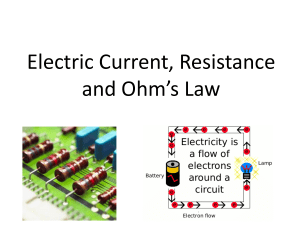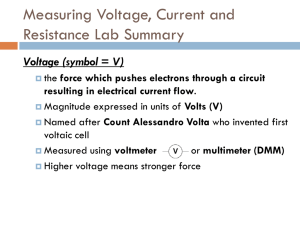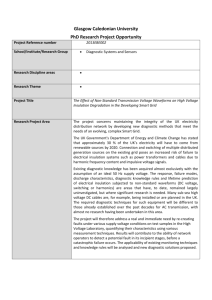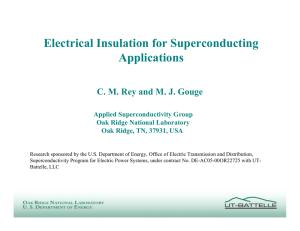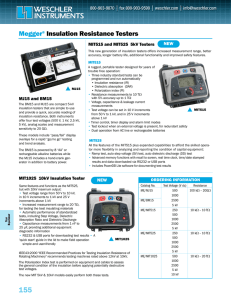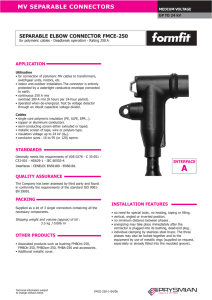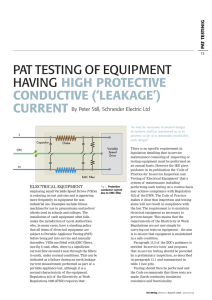Introduction
advertisement
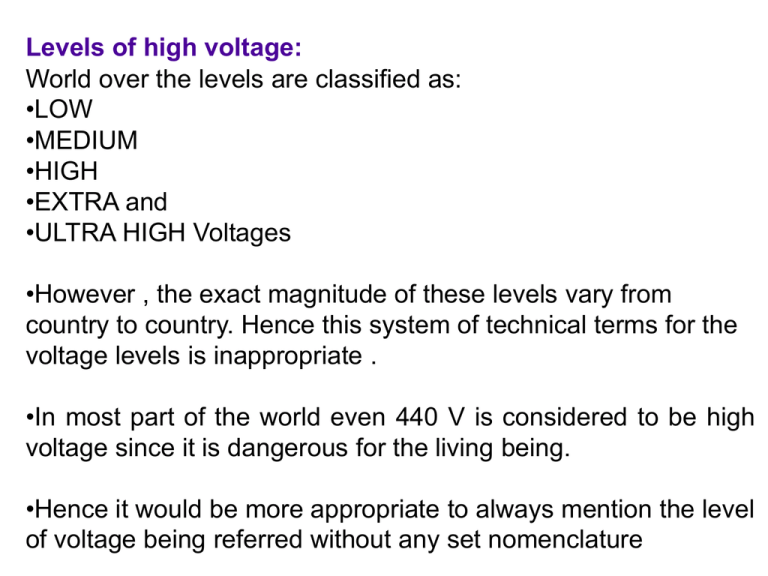
Levels of high voltage: World over the levels are classified as: •LOW •MEDIUM •HIGH •EXTRA and •ULTRA HIGH Voltages •However , the exact magnitude of these levels vary from country to country. Hence this system of technical terms for the voltage levels is inappropriate . •In most part of the world even 440 V is considered to be high voltage since it is dangerous for the living being. •Hence it would be more appropriate to always mention the level of voltage being referred without any set nomenclature VOLTAGE LEVELS Consumer •ac power frequency : 110 V, 220 V- single phase 440 V, 3.3 kV ,6.6 kV, 11 kV-three phase (3.3 & 6.6 kV are being phased out) •Besides these levels ,the Railway Traction (India) at 25 kV , single phase is one of the biggest consumer of power spread at any particular stretch to 40 km of track length . Generation : Three phase synchronous generators 440 V, 3.3 kV, 6.6 kV (small generators) , 11 kV (110 & 220 MW) 21.5 kV ( 500 MW), 33 kV (1000 MW) [limitation due to machine insulation requirement] Distribution : Three phase 440 V, 3.3 kV, 6.6 kV, 11 kV, 33 kV, 66 kV With the increase in power consumption density, the power distribution voltage levels are at rise because the power handling capacity is proportional to the square of the voltage level. (In Germany 440 V , 3.0 kV 6.0 kV, 10 kV, 30 kV, 60 kV) ac Transmission : 110 kV, 132 kV, 220 kV, 380 - 400 kV, 500 kV, 765 - 800 kV, 1000 kV and 1150 kV exist. Work on 1500 kV is complete. In three phase power system, the rated voltage is always given as line to line, rms voltage . d.c. transmission : dc single pole and bipolar lines : ± 100 kV to ± 500 kV Advance countries like US, Canada and Japan have their single phase ac power consumption level at 110 V . Rest of the whole world consumes single phase ac power at 220 V . The only advantage of 110 V single phase consumer voltage is that it is safer over 220 V. However, the disadvantages are many. Disadvantages : •It requires double the magnitude of current to deliver the same amount of power as at 220 V •Hence for the same magnitude of I2R losses to limit the conductor or the insulation temperature to 70° C (for PVC) , the resistance of the distribution cable should be 4 times lower. Therefore, the cable cross-section area has to be increased four folds. •Four times more copper requirement, dumped in the building walls is an expensive venture. •Due to higher magnitude of current, higher magnetic field in the buildings . Not good for health. •With the installation of modern inexpensive protective devices (earth fault relays), 220 V is equally safe as 110 V Rated maximum temperature of cables: •It is important to understand the current and voltage carrying capacities of a conductor separately. While the current carrying capability is determined by the conductivity of the conductors, directly proportional to the area of conductor cross-section, the voltage bearing capacity depends upon the level of insulation provided to the conductor . •The current carrying capability in turn is determined by maximum permissible temperature of the insulation or that of the conductor. •The real power loss, I2R and the rate of cooling determine the temperature rise of the conductor which should not be more than the maximum permissible temperature of the type of insulation provided on the conductor . •Hence, not only electrical but thermal and mechanical properties of insulation are important in power system . Electrical Insulation and Dielectrics Gaseous Dielectrics: •Atmospheric air is the cheapest and most widely used dielectric . Other gaseous dielectrics, used as compressed gas at higher pressures than atmospheric in power system, are Nitrogen , Sulphurhexafluoride SF6(an electro-negative gas) and it's mixtures with CO2 and N2 . SF6 is very widely applied for Gas Insulated Systems (GIS), Circuit Breakers and gas filled installations i.e. sub-stations and cables. It is being now applied for power transformers also. Vacuum as Dielectric : •Vacuum of the order of 10-5 Torr and lower provides an excellent electrical insulation. Vacuum technology developed and applied for circuit breakers in the last three decades is phenomenon . Liquid Dielectrics: •Organic liquids, the mineral insulating oils and impregnating compounds, natural and synthetic, of required physical, chemical and electrical properties are used very widely in transformers, capacitors, cables and circuit breakers. Solid Dielectrics: •Very large in number . •Most widely used are : XLPE, PVC, ceramics, glass, rubber, resins, reinforced plastics, polypropylene, impregnated paper, wood, cotton, mica, pressboards, Bakelite, Perspex, Ebonite, Teflon, etc. •Introduction of nano materials are in offing.


